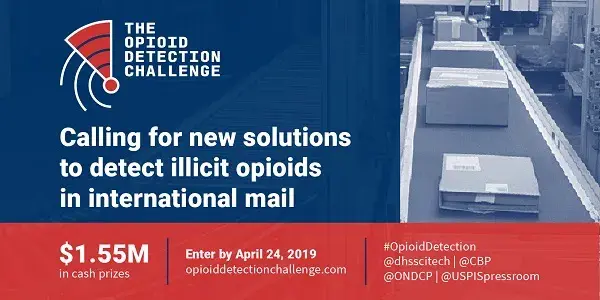The opioid crisis has devastated communities across the country, creating an unprecedented public health crisis. The Centers for Disease Control and Prevention (CDC) just released a new report, indicating that the third wave of the epidemic is underway and overdoses from fentanyl are spiking. The Department of Homeland Security (DHS) Science and Technology Directorate (S&T) is prioritizing swift interventions to help address the opioid crisis, and using open innovation to expediently source new tools to counter the supply side of the crisis.
 In February, S&T launched the Opioid Detection Challenge, a $1.55 million prize competition calling upon innovators to submit novel plans for rapid, nonintrusive detection tools that will help find illicit opioids in international mail. The competition is in collaboration with U.S. Customs and Border Protection (CBP), the Office of National Drug Control Policy (ONDCP), and the U.S. Postal Inspection Service (USPIS).
In February, S&T launched the Opioid Detection Challenge, a $1.55 million prize competition calling upon innovators to submit novel plans for rapid, nonintrusive detection tools that will help find illicit opioids in international mail. The competition is in collaboration with U.S. Customs and Border Protection (CBP), the Office of National Drug Control Policy (ONDCP), and the U.S. Postal Inspection Service (USPIS).
“The opioid crisis is one of the greatest challenges facing our nation, and S&T is committed to working with the top innovators to help fight this epidemic,” said William N. Bryan, Senior Official Performing the Duties of the Under Secretary for Science and Technology. “We know that international mail is a major route for illicit opioids entering the country, and new detection tools will be critical for cutting off the flow of these dangerous drugs.”
The Challenge is open to international and domestic participants, as detailed in the rules, terms, and conditions.
About the Challenge: What types of solutions DHS is seeking
The Challenge calls on innovators in a wide range of fields, from chemical detection to security screening to artificial intelligence, to help disrupt the flow of opioids into the United States. Submissions should be well-developed plans for automated, user-friendly tools and technologies that have the potential to quickly and accurately detect opioids in parcels, without disrupting the flow of mail.
On March 11, the Challenge hosted an informational webinar to provide an in-depth overview of the competition and share more detail on what DHS is looking for in detection solutions. Mr. Manuel Garza, Director for the Manifest & Conveyance Security Division at CBP, emphasized the importance of speed in new detection methods, given the large amount of international mail processed on a daily basis. Mr. Garza also stressed that entrants consider the adaptability of their potential solution to changing threats in the future. Watch the webinar recording for more information on what DHS is looking for in new tools and technologies.
AI/ML solutions and the Challenge: What entrants needs to know
In addition to chemical analysis or other anomaly detection methods, entrants can also submit a purely data-driven solution. A data solution does not need to develop hardware technology, as long as it can be paired with an existing hardware technology and successfully detect anomalies.
Innovators exploring data-driven solutions, such as those applying artificial intelligence or machine learning, have access to CBP x-ray scans of international mail parcels that contain opioids. Selected finalists that advance to Stage 2 will gain access to larger and more comprehensive training datasets, along with associated metadata.
Learn more about submitting a data-driven solution and other commonly asked questions.
What comes next: The accelerator and DHS’ plans for after the Challenge
Those interested in participating in the Challenge should submit their plans by 4:59 PM ET, April 24, 2019. The judges will evaluate the submissions and select up to eight finalists to advance to Stage 2 of the competition. Each finalist is expected to be awarded an equal share of the $800,000 Stage 1 prize pool.
In Stage 2, finalists will participate in a 14-week prototyping accelerator, where they will develop their plans into testable prototypes and compete for an additional $750,000 in cash prizes. During this time, finalists will receive additional support, including access to mentors, guidance from government experts, educational webinars, access to additional datasets and/or information on current processes. Stage 2 will culminate in a mandatory live test event, where finalists will convene at a government-selected facility for on-site testing of their prototypes. One grand prize winner is expected to be awarded $500,000 and one runner-up is expected to be awarded $250,000.
Following the conclusion of the Challenge, S&T and its government partners plan to continue working with the providers of the most promising solutions to further develop prototypes and establish follow-on production agreements. The government plans to deploy these tools in international mail, express consignment facilities, and other environments across the country that call for rapid, accurate detection of opioids and related substances.
